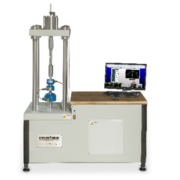What is Proof Testing and Why Does it Matter?
 Proof testing determines that the failure of critical components and parts could result in costly damage to equipment and even injury in severe cases. Our measurement products are designed to be used in proof testing applications.
Proof testing determines that the failure of critical components and parts could result in costly damage to equipment and even injury in severe cases. Our measurement products are designed to be used in proof testing applications.
In proof testing applications, testing and measuring an object’s performance under extremely intense conditions, often above the specified operational use, is critical. This allows testing engineers to ensure the object can handle its rated load and go above and beyond to understand maximum performance and failure.
Interface load cells and data acquisition systems are frequently used for proof testing, which determines the strength and integrity of a test subject by applying a controlled, measured load to it. It is commonly used for general test and measurement applications for stress, fatigue, and materials testing. It is frequently used by industries such as construction, natural resources, infrastructure, heavy machinery, and manufacturing to verify the strong point and durability of objects and structures.
Top Three Reasons Why Proof Testing Matters
#1 Safety: Proof testing qualifies and quantifies the safety of equipment and structures that sustain substantial loads. Identifying weaknesses or defects is preventative, as failure can result in catastrophe. Proof testing for safety is standard for applications that include lifting equipment, rigging gear, structural supports, and components in aircraft or spacecraft.
#2 Quality: Proof testing is common during quality control to verify that equipment or materials meet the required specifications. Whether it is the equipment used in manufacturing equipment or the materials used to construct a building, proof testing is essential in defining and measuring adherence to quality standards.
#3 Reliability: Proof testing provides accurate data on the performance and trustworthiness of the tested objects. By understanding how it reacts under stress, product engineers and testing labs can validate the lifespan of a specific component or product. It is also used to define preventative maintenance requirements. It impacts production lines, product versioning, inspections, and, ultimately, the customer’s user experience.
Proof tests provide vital safety and performance measurements for equipment or structures with significant loads. It helps to prevent accidents, improve reliability, and ensure the quality and integrity of the tested item. Consult Interface Application Engineers to determine the best measurement devices for proof testing.
Proof Testing Using Load Cells
Step One: Load Cell and Set-Up
The starting point is selecting the proper measurement tool, in this case, a load cell. Consider the object’s size, expected load range, and accuracy requirements. Choose a load cell with a capacity slightly exceeding the maximum anticipated load during use.
TIP! Use Interface’s Load Cell Selection Guide
Mount the load cell and object in a stable, controlled environment. Ensure proper alignment and distribution of force on the load cell. Connect the load cell to the data acquisition system with a dedicated readout unit, computer software, or data logger, depending on your needs.
Step Two: Pre-Test and Zeroing
Most test engineers will run a pre-test at low load. This is done by applying a small force and monitoring the readings to ensure everything functions correctly and there are no extraneous signals. Zeroing the load cell to set the baseline measurement without any applied force is important. READ: Why Is Load Cell Zero Balance Important to Accuracy?
Step Three: The Test
When you start the proof test application and data recording, most technicians will increase the load gradually. As defined in a test plan, follow a preset loading schedule, typically in increments, until reaching the desired test load. This could be a static load held for a specific time or a cyclic load simulating real-world conditions. Next, using your load cell measurement instrumentation, monitor the load cell readings, object behavior, and any potential visual deformations throughout the test.
Step Four: Analysis
The proof testing provides data that can be used to analyze the load-displacement curve, identifying any deviations from expected behavior, excessive deflections, or potential failure points. Based on the data, determine if the object met the strength and performance requirements or exhibited any unacceptable flaws. This is why a high-performance, accurate load cell matters in proof testing. It determines the quality of your analysis. As with any testing, it is valuable to maintain records of the test procedure, data, and conclusions for future reference or further analysis. This step is crucial for regulatory and product liability requirements.
The specific requirements and procedures for proof testing will vary depending on the product, equipment, structure, industry standards, and regulations.
Proof Testing Example
The most straightforward solution, where it is necessary to measure the load in a tension cable subject to safety considerations, is to enclose the load cell in a compression cage, which converts tension into compression. The compression cell is trapped between the two plates. Thus, the load cell’s only overload failure mode is in compression, allowing a motion of 0.001″ to 0.010″ before the load cell becomes solid. Even if the load cell is destroyed, the compression cage cannot drop the load unless it fails. Therefore, the cage can be proof-tested with a dummy load cell or an overload-protected cell, and the risk of injury to personnel is avoided.
TIP! This example is detailed in our Interface Load Cell Field Guide. Get your copy here.
The nature of proof testing applications requires a diverse line of performance measurement tools. Interface products extend from overload capabilities for our precision LowProfile load cells to complete DAQ systems. These options provide perfect testing solutions when necessary to push the limits on a product, component, or part.
ADDITIONAL RESOURCES
Enhancing Structural Testing with Multi-Axis Load Cells
Fatigue Testing with Interface Load Cells
Load Cells Built for Stress Testing
Benefits of Proof Loading Verification








